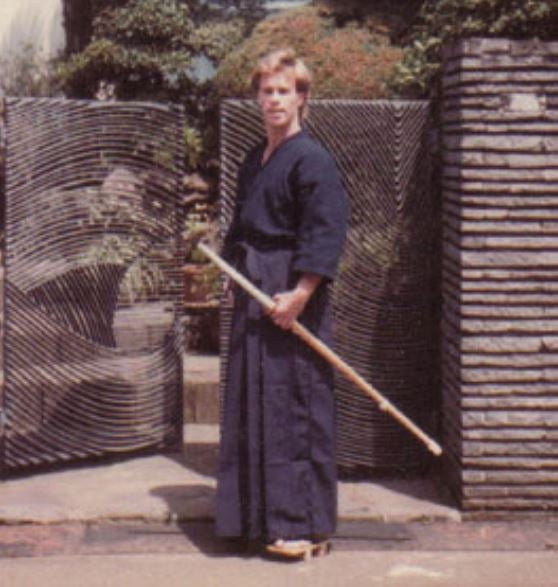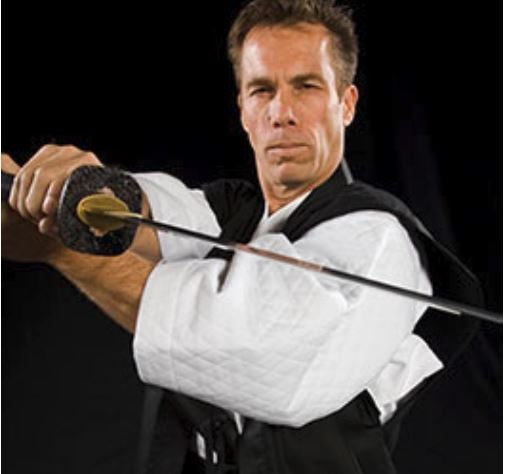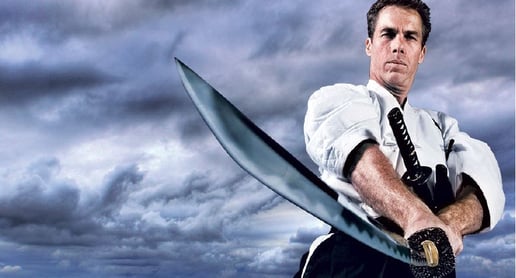Shihan Abbott’s Signature Series Classic Katana sword is traditional in design offering excellent drawing and sheathing techniques plus cutting abilities. The classic blade is particularly designed to satisfy the demands of any discriminating martial artist. The blade is hand forged 1566 steel and sharpened using refined Japanese methods to create the perfect blade for kenjutsu and iaido use. The blade is heat-treated, tempered, and then oil quenched to achieve its optimal levels of HRC40 flexibility and HRC60 hardness. This classic blade is then hand polished with multiple grades of sharpening stones, which smoothes the surface of the blade and brings out the beauty of the hamon temper ridge with the rest of the blade reflecting like a mirror.
All the fittings are special and unique which consist of an ancient Japanese family crest of arms named, “wa ni mitsu no boshi”. This crest has been associated with great samurai warriors for centuries. The ocean wave tsuba is of substantial weight and design giving the sword a feeling of more balance while the sakura cherry blossoms menuki woven into the handle offers excellent gripping balance. A keen blade coupled with the power of the ocean’s wave and the beauty of cherry blossoms. These are all synergistically designed into a well-built sword known in Japan as nami-sakura fubuki. Signature Series Classic Katana is by far the first pick of any martial art enthusiast.
Not sure which sword will fill your hand the best? View our Tutorials below.
SIGNATURE SERIES: XL KATANA
Length Overall: 41.50”
Blade: 28.25”
Handle: 12.25”
Weight: 2lb 11oz
SHOP NOW
Shihan Abbott’s Signature Series collection also incorporates the newly designed larger XL Katana sword colloquially called, “The Cutter”. This XL blade is produced strictly for serious competitive cutting and its design incorporates the geometry, strength, weight and profile needed for successful cuts on formidable targets. The XL blade is significantly wider than the classic blade, but incorporates a thinner edge that can easily cut right through and sever traditional cutting targets such as multiple rolled and soaked tatami mats. This new XL designed blade is forged and differentially tempered with a beautiful ocean wave hamon temper line along the length of the blade. The XL Katana features genuine ray skin center of the handle, with a tightly-woven black cotton wrap specially chosen for its gripping qualities. The longer tang has double mekugi safety pins for added security.
The fuchi and kashira fittings feature a “mon” family emblem motif and replicate an antique set in Shihan Abbott’s own personal collection. The handsome oval tsuba hilt is of an iron wave design, to compliment the hamon temper line along with a brass collar habaki fitting while the exquisite menuki fittings represent the flowers of sakura cherry blossoms woven into the handle with a special black cotton wrap, which, in Japan, is a very traditional motif. The wooden saya sheath, features a high-quality sageo rope and an ebony pebble-finish. This larger XL cutting blade with new-age geometry offers an exciting cutting experience.
SIGNATURE SERIES: WAKIZASHI
Length Overall: 27.50”
Blade: 20”
Handle: 6.50”
Weight: 1lb. 11oz.
SHOP NOW
Shihan Abbott’s Signature Series Wakizashi sword incorporates a traditional Japanese short sword design, which offers an excellent drawing and smooth sheathing feel plus ambidextrous cutting abilities. The shorter wakizashi blade is hand forged 1566 steel and sharpened using refined Japanese methods to create the perfect blade that is differentially hardened in the traditional manner, producing an edge hardness of HRC60 and spine hardness of HRC40. The blade is heat-treated, tempered, and then quenched to achieve its optimal levels of flexibility and hardness. The wakizashi blade is then hand polished with multiple grades of sharpening stones, which smoothes the surface of the blade and polishes the waved hamon temper line. The sword fittings are of the same design used in our classical and XL swords but are slightly reduced to accommodate and balance the wakizashi. The handle is tightly wrapped in the traditional Japanese style using a black cotton wrap to provide a positive grip that will withstand years of iaido and tameshigiri practice.
SIGNATURE SERIES: CLASSIC IAITO
Length Overall: 40”
Blade: 27.75”
Handle: 11.25”
Weight: 1lb 14oz
SHOP NOW
Shihan Abbott’s Signature Series laito is an un-edged Japanese training sword for use in drawing practice and pre arranged forms called kata. The classic sized steel alloy blade prepares the student for a greater level of proficiency to be able to advance to a live shinken blade such as, the Signature Series Classic Katana. As the Classic Katana and the Iaito employ all the same fittings for easy transition. The ocean wave tsuba is of substantial weight and design giving the sword a feeling of more balance while the sakura cherry blossoms menuki woven into the handle offers excellent gripping balance.
Signature Series Iaito training swords provide for safe drawing for the beginning practitioner of the ancient art of Iaido. Forged from stainless steel our tempered iaito blades have deeply cut blood-grooves called bo-hi running the length of the blade, which when swung correctly produces an audible feedback for better timing. Our iaito blades are maintenance-free and provide the correct weight and balance needed for the rigors of repetitive drawing and sword practice.
Japanese swords have been designed, forged and tested for their cutting abilities. There are two basic materials that were traditionally used to test the sword’s sharpness and the practitioner’s cutting abilities. One material is goza the top layer of tatami mats. They are made from a straw type grass called igusa, which is referred to in English as a soft rush straw. The second cutting material is bamboo, which is also found in abundance, as they both grow wild throughout Japan. Most of the highest quality goza tatami grasses can be found in Japan’s wetlands where they have been grown and cultivated for centuries. The lengths of grass are then woven into one-meter by two-meter sections and used as the top cover for flooring in traditional Japanese style rooms. You may have seen tatami mats in many martial arts schools used as flooring in their school’s training areas.
Begin your cutting endeavor “the traditional way” by cutting the same goza tatami mats used to test the Samurai’s mettle throughout history. Prepare each goza cutting mat by re-wrapping and rolling it to create a better feel, and a more realistic cutting experience. Soak the cutting mat in water for several hours if not overnight prior to test cutting. To learn more on how to roll a cutting mat, make you own cutting stand, and test cutting pointers just click on the tutorials links below.
THE JOURNEY OF SHIHAN DANA ABBOTT
This story could be the plot of a martial arts action movie: a young man from Arizona dreams of learning swordsmanship, sets off for Japan to follow the same path as the samurai warriors from centuries past, and studies under one of the world’s premier masters to emerge decades later as a master in his own right.

Although it would make a cool movie, this story isn’t from a film and it isn’t even fiction. Shihan Dana Abbott, seventh-degree black belt, recently recounted the story of how he came to join the ranks of top-echelon martial artist sword fighters for MASuccess magazine.
“Swordsmanship was always something that was a mystery, and held a great deal of intrigue for me,” Shihan Abbott said. “I became interested in it when I was a student at Arizona State University, and I searched, to no avail, to find a qualified instructor that I could relate to and learn from.”
Shihan Abbott graduated from Arizona State University in 1978 and went to work for a bank. It was a good, stable job, but, for Abbott, unfulfilling. He had earned a degree in geography from his time in college, and he decided to put it to use in the best way possible. He sold everything he owned that didn’t fit into a single box and ventured out onto the road.

“I started off traveling the United States, Canada, and then south to Mexico,” he said. “The next two decades were spent exploring, while living abroad in Europe and Asia while encountering many wild and crazy adventures during my treks.”
Several adventures that took place before Shihan Abbott even held a katana could warrant feature stories in their own right. He was in China during the student protests and had a bird’s-eye view of the now-infamous Tiananmen Square. Later that year he was in Berlin at the time the wall fell.
He hiked mountain trails on Everest and explored jungles in the Congo, navigated the Silk Road, and crossed deserts on camelback. From skydiving, to scuba diving, sledding in the Arctic Circle, fishing the fjords of Scandinavia and running with the bulls in Spain, Shihan Abbott did everything an adventurous spirit could hope to do – almost.
There was still swordsmanship.
Shihan Abbott has always been a person who turns thoughts into actions, so what happened next shouldn’t come as a surprise. Just as Shihan Abbott had taken his love of geography from academia to real-world experience, he decided to turn his fascination with Japanese swordsmanship into more than a mere interest.
In 1985 Abbott’s travels brought him to Japan. He enrolled in Nihon Taiiku Daigaku, Japan’s prestigious sport science university known for producing famous athletes. Getting accepted into the university was an extremely difficult process. In reminiscence, Shihan Abbott said that it was good fortune to have been granted access to Japanese culture, and the Spartan environment of the Nihon Taiiku Daigaku.

“I must have been very lucky and was in the right place at the right time,” he said.
At the university, he began to study Japan’s national combative sword sport, kendo, and Goshindo, the art of Japanese swordsmanship.
Goshindo consists of three parts: iaido, the art of drawing the sword, tameshigiri, the art of slicing objects, and kendo or kenjutsu, the art of combative sword technique and sparring.
Not content to limit his training to just schooling he began interacting with the Japanese police force. He split his time between doing police-related work with them and practicing kendo for competition to other departments.
Around this time the art of chanbara caught Shihan Abbott’s eye in the local newspaper. Similar to Western swashbuckling or gun slinging, chanbara is a Japanese sword-fighting style perhaps best associated with the movie genre of the same name (think Seven Samurai or Yojimbo). Only relatively recently, in 1971, was chanbara translated into a sport by Tetsundo Tanabe, now Chairman of the International Sport Chanbara Association.
Tanabe’s teacher was the illustrious Nakamura Taizaburo, who was knighted by the emperor for his achievements and dedication to the sword. Shihan Abbott trained at Tanabe’s Hombu Dojo in Yokohama, Japan, where he attained his current rank of Shihan, seventh-degree black belt.

Shihan Abbott liked the quick, energetic style of chanbara fighting and the fact that it used padded weapons, meaning that even very young children could start learning and experienced practitioners could spar at full speed. Despite the modern weapons, chanbara also stressed the self-discipline and precision of Goshindo. It was the best of both worlds for Shihan Abbott. He became a student of Tanabe’s, and found that his earlier sword training made him a quick study.
Although Shihan Abbott loved Japan and his training there, he believed he could make a bigger impact on martial arts world by teaching Goshindo and sport chanbara back in the USA. In 1998 Shihan Abbott
returned to Arizona and founded Samurai Sports, Inc. His establishment offers books plus instruction manuals for learning the art of the sword, as well as school programs for incorporating sword training into martial arts classes. He also provides intensive one-on-one or small group training courses. Shihan Abbott personally has taught and led seminars in over 30 countries.
When Shihan Abbott instructs a chanbara or a Zero to Sixty class, he exudes tons of energy during his fast paced classes. When he teaches traditional or Goshindo, he focuses on “the spirit of the thing” while maintaining a Zen-like teaching fashion so that all levels of students can easily understand and learn.
His dedication to helping all students learn swordsmanship goes beyond just teaching in the classroom. When he returned to the United States, he discovered that there were no practice weapons that were safe for beginning students, with the right flexibility to simulate the feel of a real sword, and durable enough to withstand full-speed sparring. Shihan Abbott solved all three problems, and today you can see his patented design in stores and schools across the country, under the name ActionFlex™.
Shihan Abbott has also authored five books, three swordsmanship training guides, an instructor’s handbook for teaching chanbara, and one historical fiction book, The 47th Ronin. His endeavors to spread Japanese swordsmanship, and his own devotion to the art, have not gone unnoticed. Since 2000, Shihan Abbott has received accolades from well-known institutions like the Black Belt Hall of Fame, USA Martial Arts Hall of Fame, Masters Hall of Fame, and Martial Arts History Museum, to name a few.
Shihan Abbott said he feels “honored by my peers and very humbled,” to have been recognized.
Shihan Abbott has no plans of slowing down any time soon. His efforts spread swordsmanship training across the United States, but he has a broader goal:
“My teacher Tanabe Tetsundo said it best,” Shihan Abbott said, recalling his mentor’s words. “He dreamed of ‘a venue where swordsmen from East and West could compete safely, fairly, free from injury… a learning center attended by a mixture of combatants embracing European, Middle Eastern, Western, Asian and African martial art styles.’”
Or, what Tetsundo and Abbott call, ‘Heaven on earth in one arena.’




